
WEED IT & REAP
Gardening is therapeutic: Joe Balderas
Nourishing lives while nourishing soil at the Sofia Quintero Art and Cultural Center
5/28/2014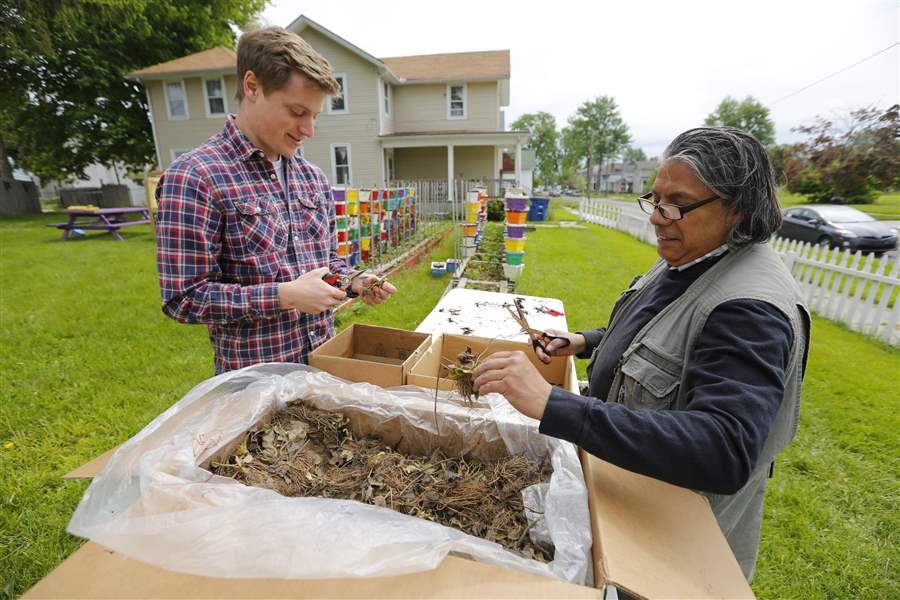
Peter Meinecke and Joe Balderas trim strawberry plants.
The Blade/Andy Morrison
Buy This Image
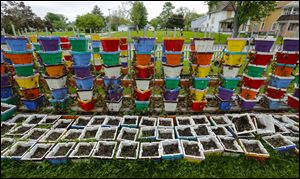
New strawberry roots were planted in baskets on vertical poles.
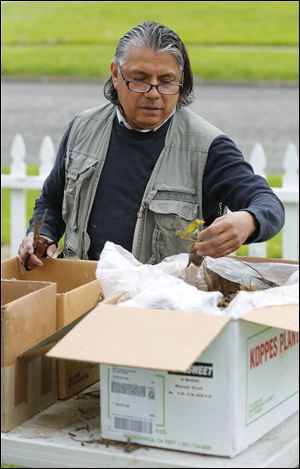
Joe Balderas sorts strawberry plants. Mr. Balderas is the garden and buildings administrator at Sofia Quintero Art and Cultural Center, in Old South Toledo.
Joe Balderas is the garden and buildings administrator at Sofia Quintero Art and Cultural Center, in Old South Toledo.
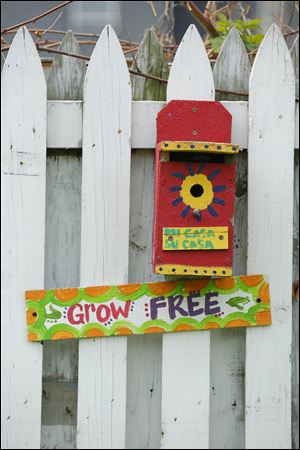
A bird house painted by youth adorns the fence.
Sofia Quintero was 34, a wife and mother of two, board member of Toledo Public Schools, and a leader in the Hispanic community when she learned she had multiple sclerosis. Petite and effervescent, she was the oldest of nine born in Texas to migrant farm workers.
Two years after she died at 46 in 1994, her friends, Maria Rodriguez-Winter and Sylvia Munoz Mutchler began organizing a nonprofit center to promote Hispanic art, culture, and language, and named it for her.
PHOTO GALLERY: Joe Balderas‘ garden at the Sofia Quintero Center
In 2002, they opened in the former Horn Hardware Store at 1224 Broadway St. in Old South Toledo, a neighborhood now enlivened with colorful murals. Purchased and donated by Ms. Rodriguez-Winter, that building became La Galeria, an art space. About five years later, she bought and donated the cavernous former movie-house, the Lyric Theater, across the street. It’s now the event space for the Sofia Quintero Art & Cultural Center where plans call for the 2015 installation of a commercial kitchen where youngsters will be taught how to eat, cook, and preserve vegetables.
Joe Balderas has worked here for 13 years, 11 of them as an employee. In 2002, Toledo Grows asked him to take charge of its overgrown community garden in the triangle next to the center. He agreed, little knowing it would become a far larger undertaking than he ever imagined.
As years went on, he obtained grants and built connections with youth groups, The Andersons, and the juvenile court, working with hundreds of volunteers, mostly urban teenagers who know zip about gardens.
He’s constructed raised beds, picnic tables, benches, a chicken coop, bird and bat houses, many of which volunteers paint with donated supplies.
The center acquired an old home behind the event center at 522 Crittendon St. along with vacant lots on either side, and it is negotiating to buy buildings across the street, said Ms. Rodriguez-Winter, interim executive director.
The event space, 1225 Broadway St., hosts a free community dinner, presentation, and socializing from 6 to 9 p.m. on the first Friday of each month. On June 6, Latino veterans and youth volunteers will be honored for their contributions.
Garden specs: Several spaces. The first was the big triangle adjacent to our building: 150-by-180-by-120-feet. We didn’t own it but the grass wasn’t cut and people complained. In late 2002, Mike Szuberla of Toledo Grows asked if I’d be the garden leader; he couldn’t get anybody to do it. The 25 raised beds made from railroad timbers were rotting and the layout was disorganized. I asked Adelante to send youth to help clean it up. They sent about 20 who were four to six years old and I thought, ‘What am I doing to do with these kids?’ But they turned everything into a game and did everything I wanted them to do.
In 2009, the city asked if they could build a demonstration rain garden here, making use of the runoff from the roof. We had about 40 to 50 volunteers helping with the eaves troughs and digging the trench for the runoff tube.
We added a native-plant garden across Crittendon Street cared for by Girls with a Cause. It’s about 60-by-80-feet and had had a garage on it that people kept torching, so Maria bought it and had it torn down. Mike Anderson of The Andersons sent garden-center staff over to design it and the next-door neighbor let me use his water.
On one side of the administration building, we have vertical strawberry gardens -- all the berries in the containers died over the winter but the berries in the ground below the containers survived. On the other side of the admin building, we’re putting in raised beds filled with plants that attract butterflies. We started 300 plants from seeds we got at Toledo Grows’ Seed Swap.
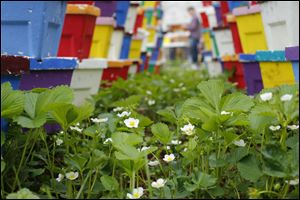
Surviving the winter were plants grown in the ground.
When did you start gardening? When my wife and I bought our home 32 years ago in South Toledo. I landscaped the heck out of it. Then the neighbors’ got termites and we started to as well. The poison treatments contaminated the soil and killed everything I’d planted. That really disappointed me.
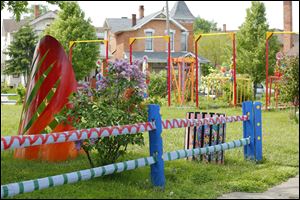
The colorful garden as seen from Broadway Street.
Here, we tried a community garden, but people didn’t take care of their plots so now we plant it with volunteers and invite anyone to help themselves to the produce.

Peter Meinecke and Joe Balderas trim strawberry plants.
What do you grow? I started keeping track of what people eat. They didn’t bother with lettuce, kohlrabi, or herbs because they don’t know what to do with them. They stole watermelons and before they were ripe, even after I built a cage for them.
They love corn and tomatoes but are skeptical of yellow ones; they think they’re not ripe. Green peppers, chiles, zucchini, cabbage, potatoes, onions, cukes, carrots. I explain how to cook eggplant.
Behind La Galeria we have 40 red and black raspberry bushes. On one side of the admin building, we have 18 vertical poles, each with four boxes of everbearing strawberries that were moderately productive in 2013. All the berries in containers died over the winter but the ones in the ground below survived.
In the native garden, there’s bee balm, joe pye weed, American cranberry bush, Japanese quince, climbing hydrangea, Japanese blood grass, and more.
Favorite plant? Raspberries. Second favorite is yellow pear tomatoes.
Give us a tip: Patience. People want it to grow into something beautiful right away. And sometimes Mother Nature can take care of herself better than we can. Raspberries seem to grow better if I leave them alone and don’t prune.
Hours spent gardening per week: About 30 this time of year.
Annual expense: We get many donations. This year, $150 for the strawberries and $150 for potting mix to start vegetables.
Challenges: Getting volunteers and educating people. I enjoy teaching. It’s a fast-food society and kids don’t have food knowledge.
I’m proud of: I completed the Master Gardening program in April and I learned that what I’m doing, I’m doing right. I’m proud that the gardens are still here, providing healthy nutrition to people of need. That’s why I continue to look for space. People have come to respect what’s being done here. We have near zero vandalism in the garden. I can’t feed the world but I can feed some people.
What do you get out of gardening? It’s relaxing, even though I’m in a go-go mode. I find it therapeutic. You’re working with a living thing. You buy this little pack of seeds and look at what it produces.
Contact Tahree Lane at: tlane@theblade.com or 419-724-6075.